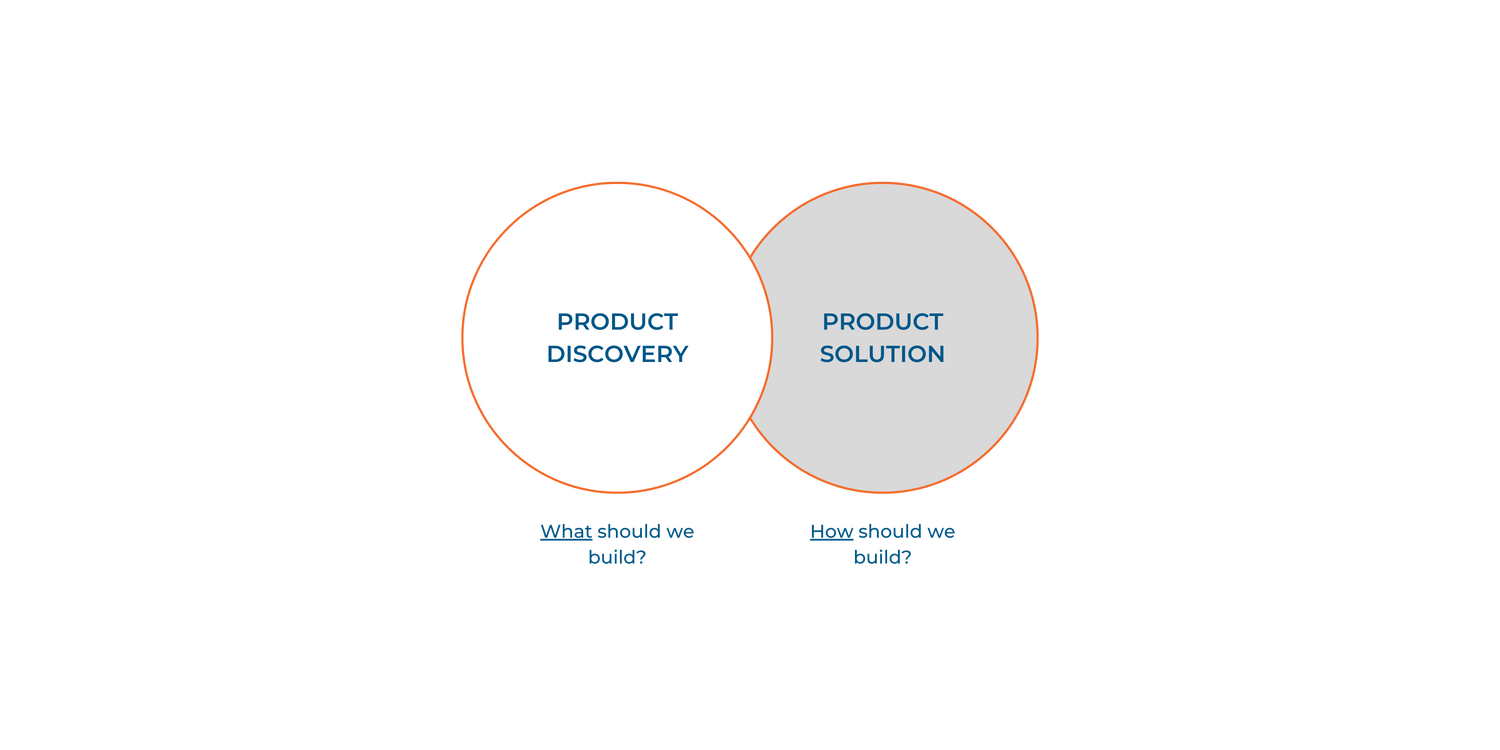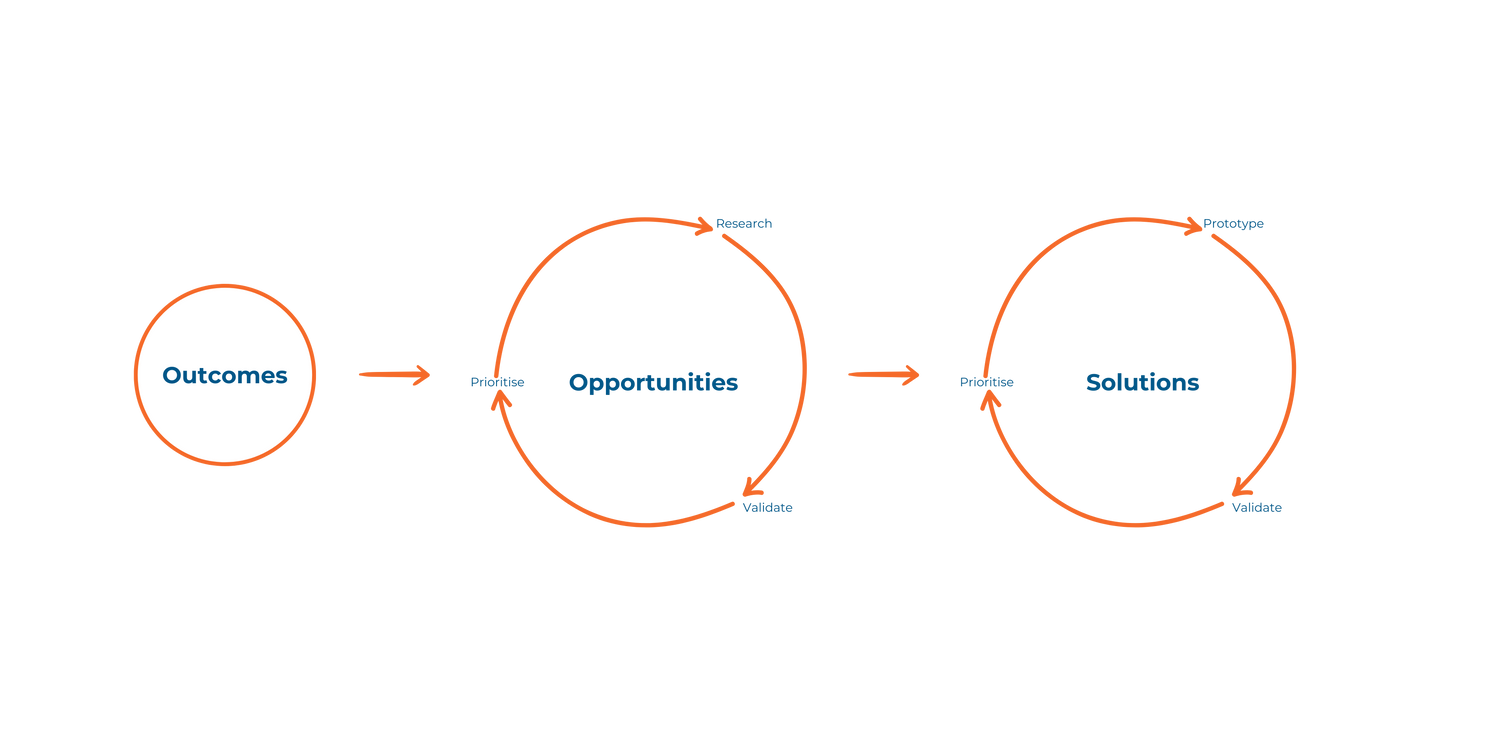Product Discovery: the blueprint for your MVP
Embarking on a journey to create a Minimum Viable Product (MVP) that resonates with your audience requires more than just a vision—it demands a structured approach to discovery. Product discovery forms the bedrock upon which successful MVPs are built, laying the groundwork for a robust and impactful digital product.
Table of contents
Understanding product discovery
Product discovery isn’t just about ideation; it’s a strategic process aimed at defining and validating the core aspects of your MVP. It involves a series of crucial steps and methodologies that guide you toward a clear and well-defined path.
A simple way to understand product discovery is to define it in contrast to product delivery. In simple terms, product discovery is about deciding what to build while product delivery is about getting it built (as efficiently as possible).

Effective product discovery prioritizes exploring the ‘opportunity space’ over rushing into the ‘solution space’.
Why a structured approach matters
A structured product discovery approach is more than a series of steps—it’s a blueprint that ensures your MVP is built on a solid foundation of user-centricity and market validation.
1. Reduced Risks & Costs: By validating assumptions early in the process, you mitigate the risk of investing resources into an MVP that might not meet user needs, saving both time and money.
2. Aligning Vision & Execution: Clear product discovery aligns the team’s vision, ensuring everyone understands the problem, the target audience and the solution to be developed.
3. Enhanced User Experience: A focus on discovery leads to a deeper understanding of users, resulting in an MVP that resonates with their preferences, leading to better adoption and engagement.
It’s crucial to acknowledge that virtually every product team engages in some form of product discovery. The challenge lies in executing it effectively. Many product teams struggle to conduct product discovery optimally, often falling short of their desired standards.
A prevalent issue among companies is the rush to ‘solutioning’—teams tend to leap directly into solutions without thoroughly identifying and comprehending the underlying problem(s) they should address. Emphasising the identification, understanding, validation and prioritisation of customer problems before delving into solutions stands as a pivotal aspect of successful product discovery.
The immediate attraction to diving into the realm of solutions is understandable. They possess tangibility and seem closest to generating impact, particularly when customers specify desired features. However, this inclination often results in companies nurturing excessively inflated roadmaps and unmanageable backlogs, growing at a pace faster than they can navigate. More significantly, it leads to teams investing substantial time and resources into solutions that fail to truly address vital customer problems, consequently lacking in customer value.
Nearly every product team has encountered the disappointment of launching a product or feature that didn’t gain the anticipated user adoption. Yet, in today’s landscape, solutions seldom falter due to poor design or construction. Companies have heavily invested in product delivery, talent acquisition and advanced processes over the past 10-20 years. The primary reason for solution failures lies in their failure to adequately address critical customer problems, not in their design or execution.
Ultimately, developing and launching a feature or product stands as the most costly method of validating an idea. Devoting more time to effective product discovery substantially mitigates the risk of building features prone to failure. To excel in product discovery, teams must shift focus from outputs (such as ‘let’s ship feature X’ or ‘product Y’) to outcomes. It involves pondering over the desired changes in customer behavior and the goals they aim to achieve. By emphasizing outcomes over outputs, teams pave the way for a more strategic and customer-centric approach to product development.
Crucial steps in product discovery: a step-by-step framework
1. Identifying Problems & Opportunities: Start by deeply understanding the problems your audience faces or the opportunities that exist within your target market. This initial step sets the stage for creating a solution that genuinely addresses user needs.
2. Market Research & Validation: Conduct thorough market research and validate your assumptions. This involves gathering insights, analysing competitors and testing hypotheses to ensure your MVP idea has a viable market.
3. User Persona Development: Define detailed user personas to understand your audience better. Uncover their pain points, preferences and behaviours to tailor your MVP to their specific needs.
4. Prototyping & User Testing: Create prototypes or mockups of your MVP and conduct user testing. This iterative process helps in refining features, functionalities and user experiences based on real user feedback.
Similar to any process, product discovery doesn’t adhere to a universal formula. However, there are steps that can enhance the effectiveness of your discovery journey. Central to this process is establishing outcomes, pinpointing opportunities and refining solutions.

1. Define your outcomes
A successful process begins with a clear goal. Similarly, in the realm of product discovery, the initial step involves defining outcomes. An outcome signifies a desired change, whether in customer behavior, product functionality, or business performance.
- Product outcomes encompass changes sought within the product itself, such as improving UI aesthetics or reducing bugs.
- Customer outcomes represent desired alterations in customer behavior, like increased feature usage or enhanced user activity.
- Business outcomes epitomize ultimate changes in business performance, such as meeting revenue goals.
These outcome types often align, with product teams translating them into specific goals like Objectives and Key Results (OKRs). A clear outcome serves as a cornerstone for the subsequent step: identifying opportunities aligned with that outcome.
2. Define, validate and prioritise opportunities
Having defined the desired outcome, the focus shifts to recognizing opportunities within the product that align with that outcome. Opportunities signify your customers’ problems, needs, or desires, presenting avenues to create value by addressing their concerns.
Prioritizing opportunities over solutions is pivotal in effective product discovery, preventing premature solutioning. Many unsuccessful features fail due to inadequately addressing significant opportunities.
Methods to identify customer issues span from user interviews to feedback analysis, particularly useful for organizations deeply engaged with customers. Subsequently, validating and prioritizing these opportunities, facilitated by quick access to customer insights, becomes imperative.
3. Test, validate and prioritise Solutions
After exhaustive research and identifying prime opportunities, the spotlight shifts to generating solutions. Solutions, be it services, features, or experiments, closely tie in with product delivery.
Unlike traditional product development, this process advocates for conceiving multiple solutions for each opportunity. Validating these solutions allows for prioritizing the ones likely to have the greatest impact on a specific opportunity.
Frameworks such as Marty Cagan‘s focus on minimising risk by assessing the value, usability, feasibility and viability of solutions.
4. The opportunity solution tree
An invaluable tool in product discovery, the Opportunity Solution Tree, developed by Teresa Torres, offers a structured visualisation of the connections between outcomes, opportunities and solutions. This framework emphasises breaking down significant, intricate opportunities into smaller, manageable segments for effective exploration and resolution.

Conclusion
In conclusion, product discovery isn’t a mere precursor to MVP development; it’s the compass guiding you toward a successful launch. By investing time and effort in a structured discovery phase, you set the stage for an MVP that not only meets user needs but also lays the groundwork for future growth and innovation.
At Tulipan Software, we offer a service called Product Roadmap Forge. It’s a collaborative process designed to bring you and our team of experts together, working hand in hand to facilitate the product discovery phase. Through Product Roadmap Forge, we leverage our collective expertise to delve deeper into your project, ensuring a comprehensive understanding of your goals, audience and market landscape. This collaborative approach enriches the product discovery process, allowing us to craft an MVP blueprint that aligns perfectly with your vision and user needs.
By investing in a structured product discovery phase and utilizing collaborative services like Product Roadmap Forge, you pave the way for an MVP that not only meets user needs but also sets the stage for scalable success.






